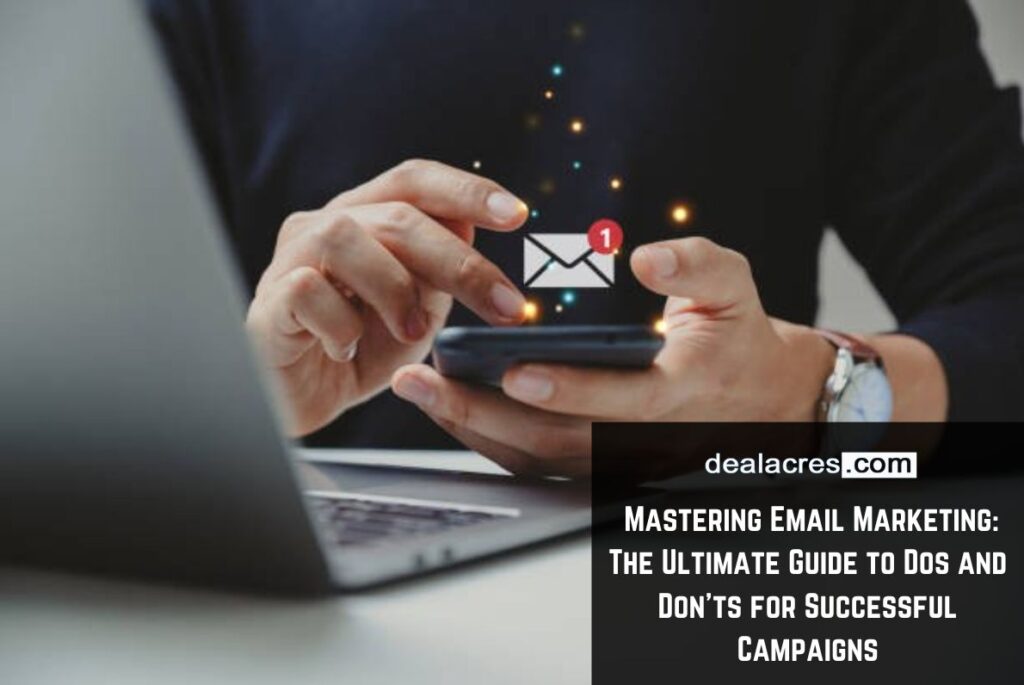Introduction:
In the vast realm of digital marketing, email remains a powerful and effective tool for reaching and engaging your audience. However, not all email campaigns are created equal. To maximize the impact of your email marketing efforts, it’s crucial to navigate the do’s and don’ts of this dynamic landscape. In this comprehensive guide, we’ll break down the dos and don’ts of email marketing campaigns in easy and simple language to help you craft messages that resonate and drive meaningful results.
The Dos of Email Marketing

- Build and Segment Your Email List Strategically
Do: Start by building a permission-based email list with individuals who have willingly opted in to receive your communications. Segment your list based on demographics, behaviors, or preferences to deliver targeted and relevant content.
Why: A well-segmented email list ensures that your messages are tailored to specific audience segments, increasing the chances of engagement and conversions.
- Craft Compelling and Personalized Content
Do: Create content that resonates with your audience. Personalize emails with recipients’ names, tailor messages based on their preferences, and use dynamic content to make your emails more relevant.
Why: Personalized and compelling content grabs attention and fosters a sense of connection, increasing the likelihood of recipients taking desired actions.
- Optimize for Mobile Responsiveness
Do: Ensure that your emails are mobile-friendly and responsive. With a growing number of users checking emails on smartphones, a mobile-optimized design enhances the user experience.
Why: Mobile optimization ensures that your messages are accessible and visually appealing across devices, reaching a broader audience.
- Use Clear and Engaging Subject Lines
Do: Craft subject lines that are clear, concise, and attention-grabbing. Be honest about the content of the email and create a sense of curiosity or urgency to encourage opens.
Why: The subject line is the first thing recipients see. A compelling subject line increases open rates and sets the tone for positive engagement.
- Include a Strong Call-to-Action (CTA)
Do: Clearly define the action you want recipients to take and incorporate a noticeable CTA in your emails. Whether it’s making a purchase, signing up, or downloading, a strong CTA guides users on the next steps.
Why: A well-defined CTA streamlines the user journey, making it easy for recipients to understand what action to take, increasing conversion rates.
- Test and Optimize Your Campaigns
Do: Conduct A/B testing on various elements of your email campaigns, such as subject lines, content, and visuals. Analyze the results and use insights to optimize future campaigns.
Why: Testing allows you to understand what resonates best with your audience, enabling continuous improvement and increased effectiveness over time.
- Personalize Your Sender Name and Email Address
Do: Use a recognizable and personable sender name and email address. Whether it’s your brand name or a specific team member, personalization adds a human touch to your emails.
Why: A personalized sender name fosters trust and increases the likelihood of recipients opening your emails.
- Comply with Email Marketing Regulations
Do: Familiarize yourself with and adhere to email marketing regulations, such as the CAN-SPAM Act or GDPR. Obtain explicit consent from subscribers, provide opt-out options, and ensure compliance with privacy laws.
Why: Compliance builds trust with your audience, avoids legal issues, and maintains a positive reputation for your brand.
The Don’ts of Email Marketing
- Don’t Purchase Email Lists
Don’t: Avoid buying email lists. It may seem like a quick way to expand your reach, but it often leads to low-quality leads, higher unsubscribe rates, and damage to your sender reputation.
Why: Purchased lists can contain outdated or irrelevant contacts, harming your deliverability and tarnishing your brand’s image.

- Avoid Sending Emails Without Permission
Don’t: Only send emails to individuals who have explicitly opted in to receive communications from you. Sending unsolicited emails, commonly known as spam, can damage your sender reputation.
Why: Permission-based emails ensure that recipients are interested in your content, leading to higher engagement rates.
- Don’t Overwhelm Subscribers with Excessive Emails
Don’t: Bombard your subscribers with a high frequency of emails. Too many messages can lead to fatigue, increased unsubscribes, and a negative perception of your brand.
Why: A balanced and strategic email frequency maintains engagement without overwhelming your audience.
- Avoid Misleading Subject Lines
Don’t: Steer clear of misleading or clickbait subject lines. Misrepresentation can lead to frustration, decreased trust, and damage to your brand’s reputation.
Why: Honest and clear subject lines build trust and set the right expectations for your audience.
- Don’t Neglect Mobile Optimization
Don’t: Neglect the importance of mobile optimization. Failing to ensure that your emails are mobile-friendly can result in a poor user experience for a significant portion of your audience.
Why: Mobile optimization is crucial as a growing number of users access emails on smartphones. A poor mobile experience may lead to missed opportunities and lower engagement.
- Avoid Generic and Irrelevant Content
Don’t: Send generic and irrelevant content to your subscribers. Tailor your messages based on user preferences, behaviors, and demographics to ensure that your content remains valuable.
Why: Relevant content fosters engagement and strengthens the connection between your brand and your audience.

- Don’t Use Misleading Sender Names
Don’t: Use deceptive or unclear sender names and email addresses. Recipients should easily identify who the email is from to establish trust.
Why: A recognizable sender name builds credibility and increases the likelihood of recipients opening your emails.
- Don’t Ignore Analytics and Feedback
Don’t: Ignore analytics and feedback from your email campaigns. Regularly review metrics such as open rates, click-through rates, and conversion rates. Pay attention to feedback and adjust your strategy accordingly.
Why: Analytics provide valuable insights into the performance of your campaigns. Monitoring feedback helps you understand audience preferences and continuously improve your approach.
Conclusion
Email marketing remains a potent tool for businesses seeking to connect with their audience in a direct and personalized way. By adhering to the dos and avoiding the don’ts of email marketing, you can craft campaigns that resonate, build trust, and drive meaningful results. Remember, successful email marketing is a dynamic process that requires a keen understanding of your audience, continuous optimization, and a commitment to delivering value with every message. As you embark on your email marketing journey, keep these guidelines in mind, and watch your campaigns flourish into powerful avenues for engagement and growth.




